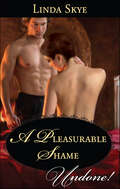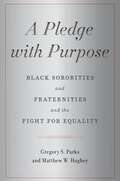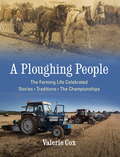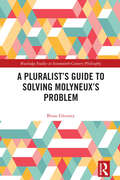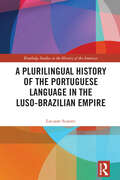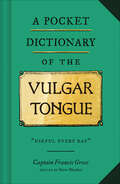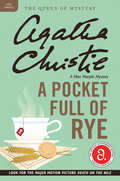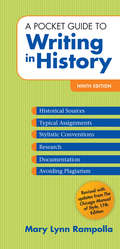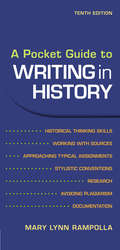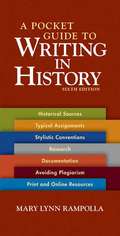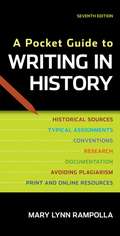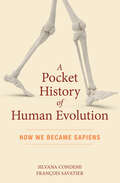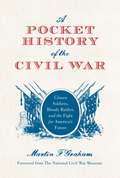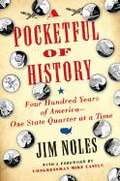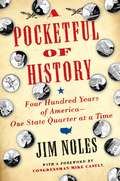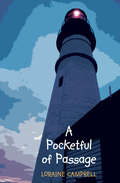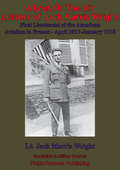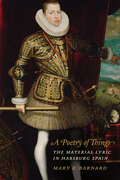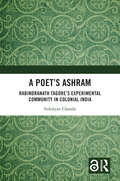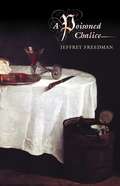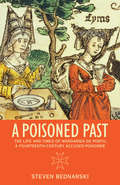- Table View
- List View
A Pleasurable Shame (Undone!)
by Linda SkyeFrance, 1067Giselle believes she only has a loveless arranged marriage in her future-until the son of her feudal lord claims droit du seigneur, the right to take her virginity. The young peasant woman feels a scandalous thrill at being wanted by the handsome and virile Eustache de Fiennes. If she is to be ruined, she vows to take pleasure in her fate-and to do everything she can to ensure Eustache is not content with just one night of passion...
A Pledge with Purpose: Black Sororities and Fraternities and the Fight for Equality
by Matthew W. Hughey Gregory S. ParksReveals the historical and political significance of “The Divine Nine”—the Black Greek Letter OrganizationsIn 1905, Henry Arthur Callis began his studies at Cornell University. Despite their academic pedigrees, Callis and his fellow African American students were ostracized by the majority-white student body, and so in 1906, Callis and some of his peers started the first, intercollegiate Black Greek Letter Organization (BGLO), Alpha Phi Alpha. Since their founding, BGLOs have not only served to solidify bonds among many African American college students, they have also imbued them with a sense of purpose and a commitment to racial uplift—the endeavor to help Black Americans reach socio-economic equality. A Pledge with Purpose explores the arc of these unique, important, and relevant social institutions. Gregory S. Parks and Matthew W. Hughey uncover how BGLOs were shaped by, and labored to transform, the changing social, political, and cultural landscape of Black America from the era of the Harlem Renaissance to the civil rights movement. Alpha Phi Alpha boasts such members as Thurgood Marshall, civil rights lawyer and US Supreme Court Justice, and Dr. Charles Wesley, noted historian and college president. Delta Sigma Theta members include Bethune-Cookman College founder Mary McLeod Bethune and women’s rights activist Dorothy Height. Huey P. Newton, co-founder of the Black Panther Party, who left an indelible mark on the civil rights movement, was a member of Phi Beta Sigma, while Dr. Mae Jemison, a celebrated engineer and astronaut, belonged to Alpha Kappa Alpha. Through such individuals, Parks and Hughey demonstrate the ways that BGLO members have long been at the forefront of innovation, activism, and scholarship.In its examination of the history of these important organizations, A Pledge with Purpose serves as a critical reflection of both the collective African American racial struggle and the various strategies of Black Americans in their great—and unfinished—march toward freedom and equality.
A Ploughing People: The Farming Life Celebrated - Stories, Traditions, The Championships
by Valerie CoxJourney into the heartland of rural Ireland, in words and images, from the 1930s to today. Meet the characters behind the Ploughing Championships, past and present. Witness the traditions and stories from a changing way of life, where community spirit remains central, and the plough keeps turning the sod, year on year . . .Since the early 1930s, The National Ploughing Championships has occupied a special place in the heart of ruralIrish life, when people gather from every corner of the country to show off their skills and engage in sport, fun and business. Here, for the first time, the magic of the Ploughing is captured in word and image. We follow Valerie Cox as she journeys around Ireland to meet the people who make this national institution great, and record the stories of what the ploughing means to them, whether it's vintage tractors, a pair of Clydesdales or a plough handed down from a grandfather.Among others, we meet three-time world champion Martin Keogh, take an unforgettable trip to Thady Kelleher country in East Cork, and are enchanted by the first even Queen of the Plough Anna Mai Donegan, who won her crown in 1955.This beautiful book also provides a record of a landscape that may bear little resemblance to that of the 1930s but, in important ways - of family, community and the nod and wink of the business deal - is little changed. A gift, a keepsake, A Ploughing People is a unique celebration of the best of Irish life.
A Pluralist’s Guide to Solving Molyneux’s Problem (Routledge Studies in Seventeenth-Century Philosophy)
by Brian GlenneyThis book presents a novel pluralist strategy for answering Molyneux’s 300+-year-old conundrum: Would a person, born blind but given sight, identify a shape previously known only by their touch? The author interweaves historical scholarship with contemporary philosophical work and empirical research on animal, infant, and adult human perception.The author argues that we need a new approach to Molyneux’s problem because we do not know what the problem is really about, and it is untestable because a Molyneux subject cannot be physically realized. He criticizes Molyneux’s question for its simplistic taxonomy of "the blind" that groups significant individual differences into a singular ontology. Research in the cognitive sciences confirms that various kinds of blindness can co-occur, such as ocular, cortical, and psychological blindness. Therefore, the author adopts an explanatory pluralism for answering Molyneux’s problem, which includes no, yes, and "no answer" answers according to the domain of inquiry being used. This account provides a research-based answer to a long-standing problem using previously unheeded insights particularly from animal crossmodal perception studies to retell a more complex story of perception: its levels of explanation and integration.A Pluralist’s Guide to Solving Molyneux’s Problem will be of interest to researchers and advanced students working in comparative psychology, epistemology, history of philosophy, philosophy of perception.
A Plurilingual History of the Portuguese Language in the Luso-Brazilian Empire
by Luciane ScaratoThis book investigates the diverse ways in which the Portuguese language expanded in Brazil, despite the multilingual landscape that predominated before and after the arrival of the Europeans and the African diaspora. Challenging the assumption that the prevalence of Portuguese was a natural consequence and foregone conclusion of colonisation, the book argues that the language’s expansion was as much a result of state intervention as of individual agency. The growth of the Portuguese language was a tumultuous process that mirrored the power relations and conflicts between Amerindian, European, African, and mestizo actors who shaped, standardised, and promoted the language within and beyond state institutions. Knowing Portuguese became an identification sign of being Brazilian. However, a significant number of languages disappeared along the way, and the book highlights that virtual language homogeneity does not imply social equality. Portuguese’s variants place speakers on different social levels that justify domination and inequality. This research tells the history of a victorious language and other languages that left their mark on Brazilian Portuguese. A Plurilingual History of the Portuguese Language in the Luso-Brazilian Empire is a useful resource for scholars interested in the history and standardisation of languages, Portuguese and Brazilian history, and the impacts of colonisation.
A Pocket Dictionary of the Vulgar Tongue
by Captain Francis GroseA profane guide to the slang from eighteenth-century London&’s backstreets and taverns and how to use the antique jargon and curse words in modern conversation. This slang dictionary gathers the most amusing and useful terms from English history and helpfully presents them to be used in the conversations of today. Originally published in 1785, A Classical Dictionary of the Vulgar Tongue was one of the first lexicons of English slang, compiled by a militia captain who collected the terms he overheard on his late-night excursions to London&’s slums, dockyards, and taverns. Now the legacy lives on in this colorful pocket dictionary. Learn the origin of phrases like &“birthday suit&” and discover slang lost to time An unexpected marriage of lowbrow humor and highbrow wit A Pocket Dictionary of the Vulgar Tongue is perfect for enlivening contemporary conversation with historical phrases; it includes a topical list of words for money, drunkenness, the amorous congress, male and female naughty bits, and so on. A funny book for wordplay, language, swearing, and insult fans, as well as fans of British humor and culture Perfect for those who loved How to Speak Brit: The Quintessential Guide to the King&’s English, Cockney Slang, and Other Flummoxing British Phrases by Christopher J. Moore; Knickers in a Twist: A Dictionary of British Slang by Jonathan Bernstein; and The Official Dictionary of Sarcasm by James Napoli
A Pocket Full of Rye: A Miss Marple Mystery (Miss Marple Mysteries #6)
by Agatha ChristieIn Agatha Christie’s classic, A Pocket Full of Rye, the bizarre death of a financial tycoon has Miss Marple investigating a very odd case of crime by rhyme.Rex Fortescue, king of a financial empire, was sipping tea in his “counting house” when he suffered an agonizing and sudden death. On later inspection, the pockets of the deceased were found to contain traces of cereals.Yet, it was the incident in the parlor which confirmed Miss Marple’s suspicion that here she was looking at a case of crime by rhyme. . . .
A Pocket Full of Seeds
by Marilyn SachsNicole Nieman has never really thought about being Jewish. Now, with the Nazis occupying France, it is the only thing on her mind. An almost endless stream of refugees comes to stay at their house, and her parents wonder if they too ought to escape over the border to switzerland or take the chance and wait it out. Then one awful day Nicole comes home from school to find her parents and her sister gone. The Nazis who have taken them are still looking for her. Where can Nicole hide? And will she ever see her family again?<P><P> Jane Addams Children’s Book Award Honor Book
A Pocket Guide to Writing in History
by Mary RampollaA Pocket Guide to Writing in History is a brief, inexpensive, and easy-to-use guide to the writing and research skills needed for undergraduate history courses. Its concise yet comprehensive coverage of every step of the research and writing process--including detailed advice on documenting sources and avoiding plagiarism--have made A Pocket Guide to Writing in History the trusted choice in history.
A Pocket Guide to Writing in History
by Mary RampollaA Pocket Guide to Writing in History is the concise, trusted, and easy-to-use guide for the writing and research skills needed in undergraduate history courses. Thoroughly updated to include strategies for making useful outlines and organizing a paper, the tenth edition ensures that students have the most up-to-date advice and ample instruction for writing a research paper for their history class.
A Pocket Guide to Writing in History (6th edition)
by Mary Lynn RampollaA portable and affordable reference tool, A Pocket Guide to Writing in History provides reading, writing, and research advice useful to students in all history courses. Concise yet comprehensive advice on approaching typical history assignments, developing critical reading skills, writing effective history papers, conducting research, using and documenting sources, and avoiding plagiarism -- enhanced with practical tips and examples throughout -- have made this slim reference a best-seller. Now in its sixth edition, the book offers more coverage of working with sources than ever before.
A Pocket Guide to Writing in History (7th Edition)
by Mary Lynn RampollaAn essential writing, reading, and research tool for all history students, A Pocket Guide to Writing in History offers a best-selling combination of concise yet comprehensive advice in a portable and accessible format. This quick-reference guide provides a practical introduction to typical history assignments, exercising critical reading skills, evaluating and documenting sources, writing effective history papers, conducting research, and avoiding plagiarism. Building on its time-tested approach, the seventh edition offers expanded, hands-on guidance for writing and researching in the digital age, and additional coverage on working with primary and secondary sources.
A Pocket History of Human Evolution: How We Became Sapiens
by Silvana Condemi François SavatierWhy aren’t we more like other apes? How did we win the evolutionary race? Find out how “wise” Homo sapiens really are. Prehistory has never been more exciting: New discoveries are overturning long-held theories left and right. Stone tools in Australia date back 65,000 years—a time when, we once thought, the first Sapiens had barely left Africa. DNA sequencing has unearthed a new hominid group—the Denisovans—and confirmed that crossbreeding with them (and Neanderthals) made Homo sapiens who we are today. A Pocket History of Human Evolution brings us up-to-date on the exploits of all our ancient relatives. Paleoanthropologist Silvana Condemi and science journalist François Savatier consider what accelerated our evolution: Was it tools, our “large” brains, language, empathy, or something else entirely? And why are we the sole survivors among many early bipedal humans? Their conclusions reveal the various ways ancient humans live on today—from gossip as modern “grooming” to our gendered division of labor—and what the future might hold for our strange and unique species.
A Pocket History of the Civil War
by Martin GrahamPraise for: A Pocket History "Martin F. Graham's A Pocket History of the Civil War is a font of information that will interest a wide range of readers, including the ardent history buff." --Foreword Magazine Martin Graham, a former associate editor of Blue & Gray magazine, has penned a new book entitled A Pocket History of the Civil War. The book is published in conjunction with The National Civil War Museum in Harrisburg Pennsylvania. Each of the books' eight chapters presents a different theme, ranging from the transformation of civilians into soldiers to the prison systems of North and South. Graham also provides 4-5 page overviews of each of the key battles of war from Fort Sumpter to Appomattox. The final chapter offers brief biographies of eight unusual characters from the war--and an surprising event from its aftermath. An appendix provides a "test your knowledge" section, a glossary, and a list of books further reading. Civil War buffs will enjoy the many tables that Graham provides. For example, there is a table that lists the greatest percentage of regimental loss in battle (for the Union it was 1st Minnesota which lost 82% at Gettysburg and for the Confederacy it was the 3rd North Carolina which lost 90% at Antietam). Another table lists the higher ranking generals killed in battle and their manner of death. History buffs will relish the information Graham serves up on the economics of the war, camp life, and such lesser-known personalities as Johnny Clem, "the drummer boy of Shiloh." For readers new to the war, or who have become interested in it due to the Sesquicentennial, Graham has provided, a concise overview that is sure to inspire further study. In his Foreword to the book, David A. Patterson, CEO of the National Civil War Museum in Harrisburg writes, "Incorporating all of the fundamental information about the Civil War in one concise, easy to reference and well laid-out volume makes this an essential purchase for the Sesquicentennial Commemoration."From the Hardcover edition.
A Pocketful of History: Four Hundred Years of America One State Quarter at a Time
by Jim NolesA HISTORY-RICH LOOK at the coins in your pocket-the fifty state quarters-and what they tell us about "changing" America Our past is all around us-even in the spare change jangling in your purse or pocket. For the past decade, the United States Mint has offered America a pocketful of history through its popular 50 State Quarters® Program. When the final quarters are released, thousands of us will have collected these commemorative coins, one for each state and territory in the Union. But what can we learn about our country's stories and lore from a mere $12.50 in state quarters? Jim Noles's fascinating book, A Pocketful of History, looks at each quarter in turn to answer these curious questions . . . * Who is Caesar Rodney and why is he riding a horse on Delaware's quarter? * What is the real history behind Abraham Lincoln's political career in his home state Illinois? * What happened to New Hampshire's symbol, the "Old Man in the Mountain," three years after its quarter was minted? * What famous racecourse is memorialized on the quarter from the state known as the "Crossroads of America"? Congress recently extended the program to include six additional quarters for Washington, D.C., and the affiliated territories of the United States, to be released in 2009. Why is Pennsylvania known a the Keystone State? Why did California choose to honor preservationist John Muir rather than a mining '49er? . . . and many, many more. A Pocketful of History tells the story behind each state's quarter-how each state chose its design; what is important about the people, scenes, and themes depicted on the coins; and what the collection tells us about ourselves. It's an entertaining and enlightening journey through four hundred years of America in twenty-five-cent doses.
A Pocketful of History: Four Hundred Years of America--One State Quarter at a Time
by Jim NolesThe U.S. Mint’s Fifty State Quarters Program-its most ambitious program to date-has been a huge popular success.<P><P> When the final state quarters are released in 2008, many thousands of individuals will have collected one commemorative quarter for each state in the Union. But what can we learn about our country’s history and culture from $12.50 worth of quarters? A Pocketful of History tells the intriguing story behind each state’s quarter: how each state chose its quarter’s design; what is important about the people, scenes, or themes depicted on the coin; and what the collection tells us about how we view ourselves and our heritage. A Pocketful of History will guide readers on a fascinating journey through America’s rich history of change.
A Pocketful of Passage: Pocketful Of Passage
by Loraine CampbellA fictionalized account of the life of a lighthouse keeper's daughter and her family on the Great Lakes in the 1940s, written for young readers ages 8 and up.
A Pocketful of Silver: Secrets of the past threaten a young woman’s future happiness
by Anne BakerSome secrets cannot remain buried forever... Anne Baker's thrilling saga, A Pocketful of Silver, follows a young woman growing up amidst clouds of secrets and intrigue, and her journey to discovery. Perfect for fans of Nadine Dorries and Cathy Sharp.It's 1920, and Ellie Valentino is just like any other happy five-year-old growing up in Birkenhead. Although her father is dead, and her mother works hard, Ellie's grandmother, Bridie, is always there to provide a welcoming hug when the little girl returns from school. But, one tragic day, Ellie's secure world is suddenly torn apart with the mysterious death of her mother, and Ellie is forced to live with her uncle Mick, a man with a violent temper. As the years pass, Ellie's yearning to know the truth about her mother's death never fades - it even casts a shadow over her blossoming romance with childhood friend, Franco Baldini. For Franco knows more about that fateful day than he dares admit, especially to Ellie. Can their love survive when Ellie longs to uncover events that Franco is desperate to forget? And will Ellie ever find out what really happened to her mother? What readers are saying about A Pocketful of Silver: 'Definitely recommend, these books are very well written and they're hard to put down once you've started''Brilliant book and a great story - a very enjoyable read'
A Poet Of The Air; Letters Of Jack Morris Wright: First Lieutenant Of The American Aviation In France, April, 1917-January, 1918
by Jack Morris Wright Sara Greene Wise"THESE letters from my son, I gathered for publication just as they came, with the full joy and pride I had in receiving them, hoping to give to other boys something of his fine courage and spirit --- to other mothers comfort and hope, and to all readers the vivid, beautiful sketches of France, of War, of Idealism as he, "Poet of the Airs," has given me.Jack Wright, the author of these letters is an American boy of eighteen years, born in New York City. When a small child he was taken to France, where he remained until the outbreak of the war.He was educated entirely in French schools; his playmates were the children of the artists and poets of France. French was his language. This will explain his unique literary expression, the curious blend of French and English which, even to the formation of words, I have left entirely as he writes them, feeling therein a special charm.This will explain also his great love for France, the home of his childhood.Although but eighteen years old when he left to make the supreme sacrifice as one of the first American Volunteers, he had graduated with special honors from l'École Alsacienne at Paris and Andover in America, and entered Harvard University.Although only nine months in the war, he had won his commission as First Lieutenant Pilot-Aviator of the American Aviation.While joyously compiling these letters (having even confided my plan to him) the official telegram came that announced his last flight, January 24, 1918.
A Poetics of Third Theatre: Performer Training, Dramaturgy, Cultural Action (Perspectives on Performer Training)
by Patrick Campbell Jane TurnerA Poetics of Third Theatre offers an in-depth, critical analysis of Third Theatre, a transnational community of theatre groups and artists united by a shared set of values and a laboratory attitude. This book takes a genealogical account of Third Theatre as a concept and a practice that draws attention to the historical Third Theatre Encounters that have taken place across Europe and Latin America since the 1970s. The work of renowned Third Theatre groups and organisations, such as LUME (Brazil), Grupo Cultural Yuyachkani (Peru), Triangle Theatre (UK) and Nordisk Teaterlaboratorium – NTL (Denmark), are explored to reveal how a multifarious poetics of Third Theatre is manifest through these artists’ approaches to performer training, dramaturgy and cultural action. Three critical pillars – unconditional hospitality, artisanal craft and (re)enchantment – are employed in order to illuminate the shared ethos of the Third Theatre community and its exemplification as a mode of cultural performance. This informative text will be of great use to students and scholars of drama and theatre studies, and its dedicated section on performer training exercises offers the reader pathways into an experiential engagement with Third Theatre craft.
A Poetry Precise and Free: Selected Madrigals of Guarini
by Nicholas JonesA Poetry Precise and Free collects 150 lyric poems by the Renaissance Italian poet Giovanni Battista Guarini in new translations, accompanied by the Italian originals and commentary that will enlighten and engage both scholars and general readers. Guarini’s madrigals provide insight into northern Italian court culture of the late Renaissance, when poetry and music were enjoyed as companion arts. Hundreds of composers of Guarini’s day set his lyric poems to music. Primarily known today in their vocal settings, most famously those of Claudio Monteverdi, the poems merit appreciation in their own right. This volume is organized into ten sections, grouping the madrigals around themes such as the anguish of passion, the asymmetry of desire, the incursions of jealousy, and the possibility of mutual bliss. Nicholas R. Jones renders Guarini’s poetry into accessible contemporary English verse that nevertheless stays true to the substance and form of the original texts, reflecting their roots in the Petrarchan poetic tradition and displaying the emotion and musicality that made these lyrics so popular from the start. A substantive introduction provides cultural context for the madrigals and their musical settings; brief commentaries follow each translation to illuminate aspects of poetic and rhetorical craft. An extensive appendix lists the madrigal compositions that set these lyrics for vocal performance. The book fills a major gap in the scholarship on Guarini’s literary legacy. It will appeal to scholars of literature, Renaissance studies, and musicology, early-music performers, and general readers interested in poetry and classical music.
A Poetry of Things: The Material Lyric in Habsburg Spain (Toronto Iberic)
by Mary E. BarnardA Poetry of Things examines the works of four poets whose use of visual and material culture contributed to the remarkable artistic and literary production during the reign of Philip III (1598–1621). Francisco de Quevedo, Luis de Góngora, Juan de Arguijo, and Luisa de Carvajal y Mendoza cast cultural objects – ranging from books and tombstones to urban ruins, sculptures, and portraits – as participants in lively interactions with their readers and viewers across time and space. Mary E. Barnard argues that in their dialogic performance, these objects serve as sites of inquiry for exploring contemporary political, social, and religious issues, such as the preservation of humanist learning in an age of print, the collapse of empires and the rebirth of the city, and the visual culture of the Counter-Reformation. Her inspired readings explain how the performance of cultural objects, whether they remain in situ or are displayed in a library, museum, or convent, is the most compelling.
A Poet’s Ashram: Rabindranath Tagore’s Experimental Community in Colonial India
by Sukalyan ChandaThe remarkably creative life Rabindranath Tagore (1861–1941) lived has long been an area of scholarly enquiry. Yet, surprisingly, his role as the founder of an experimental ashram community remains unexplored. A Poet’s Ashram retrieves his idea of his ashram through an exploration of his writings on the institutions he built.The ashram community Tagore endeavoured to create in Santiniketan during the period 1901–1941 was his response to the question of modernity. Through his effort to reinvent the ancient Indian ideal of the ashram, he articulated his idea of a mode of collective living that was meant to be grounded in a set of ethical values derived from India’s civilizational inheritance. This book traces the history of how his ashram school evolved into a community that practised egalitarianism, inclusiveness and creativity through its daily existence. It explores a range of nineteenth- and twentieth-century discourses and Tagore’s engagement with them in order to situate that idea within its historical context, a critical juncture in the history of modern India and the world. This book’s reading of his project unravels its anti-colonial underpinnings and the commonalities it shared with some of the other similar experimental communities that challenged illiberal ideologies and power relations during the early twentieth century.Meticulously researched and perceptively written, this book will be of interest to students and researchers of history, political science, culture studies and postcolonial studies. It will also be of interest to educationists, educators and those interested in colonial modernity, modern Indian history, philosophy of education, institution building, peace, inclusivity and sustainability.
A Poisoned Chalice
by Jeffrey FreedmanA Poisoned Chalice tells the story of a long-forgotten criminal case: the poisoning of the communion wine in Zurich's main cathedral in 1776. The story is riveting and mysterious, full of bizarre twists and colorful characters--an anti-clerical gravedigger, a hard-drinking drifter, a defrocked minister--who come to life in a series of dramatic criminal trials. But it is also far more than just a good story. In the wider world of German-speaking Europe, writes Jeffrey Freedman, the affair became a cause célèbre, the object of a lively public debate that focused on an issue much on the minds of intellectuals in the age of Enlightenment: the problem of evil. Contemporaries were unable to ascribe any rational motive to an attempt to poison hundreds of worshippers. Such a crime pointed beyond reason to moral depravity so radical it seemed diabolic. By following contemporaries as they struggled to comprehend an act of inscrutable evil, this book brings to life a key episode in the history of the German Enlightenment--an episode in which the Enlightenment was forced to interrogate the very limits of reason itself. Twentieth-century horrors have familiarized us with the type of evil that so shocked the men and women of the eighteenth century. Does this familiarity give us any special insight into the affair of the poisoned chalice? In its final chapter, the book takes up this question, reflecting on the nature of historical knowledge through an imaginary dialogue with Enlightenment-era interlocutors. But it does not reach any definitive conclusion about what happened in the Zurich cathedral in 1776. To search for the truth about such a mystery is merely to extend a dialogue begun in the eighteenth century, and that dialogue is as open-ended as the process of Enlightenment itself.
A Poisoned Past: The Life and Times of Margarida de Portu, a Fourteenth-Century Accused Poisoner
by Steven BednarskiThis is the story of Margarida de Portu, a fourteenth-century French medieval woman accused of poisoning her husband to death. As Bednarski points out, the story is important not so much for what it tells us about Margarida but for how it illuminates a past world. Through the depositions and accusations made in court, the reader learns much about medieval women, female agency, kin networks, solidarity, sex, sickness, medicine, and law. Unlike most histories, this book does not remove the author from the analysis. Rather, it lays bare the working methods of the historian. Throughout his tale, Bednarski skillfully weaves a second narrative about how historians "do" history, highlighting the rewards and pitfalls of working with primary sources. The book opens with a chapter on microhistory as a genre and explains its strengths, weaknesses, and inherent risks. Next is a narrative of Margarida's criminal trial, followed by chapters on the civil suits and appeal and Margarida's eventual fate. The book features a rough copy of a court notary, a notorial act, and a sample of a criminal inquest record in the original Latin. A timeline of Margarida's life, list of characters, and two family trees provide useful information on key people in the story. A map of late medieval Manosque is also provided.
